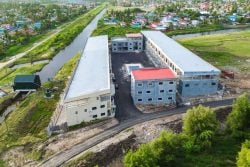Thirty years ago the International Conference on Population and Development (ICPD) Programme of Action was adopted by 179 countries. Apart from what is spelt out in the ICPD’s name – population and development – the programme sought to address the rights of adolescents, who in 1994 were still largely not recognised as a group with very specific needs. Since then, significant strides have been made towards this end, including but not limited to distinct Millennium Development Goals followed by Sustainable Development Goals (SDGs) related to the section of the population aged 10 to 19 years old. However, as with everything else, the progress has been uneven.
Indeed there have been advancements, particularly in the education (academics) of adolescents. Pre-Covid data indicated significant increases in the numbers of youth both entering and graduating from secondary education facilities. Unfortunately, this data was slightly wobbly because while taken holistically the global statistics showed marked improvement, dissected by region and by country there were clear gaps; some areas were failing and continue to do so. With regard to other noted targets in the SDGs: universal access to sexual and reproductive health, bodily autonomy, gender-based violence, and empowerment, the figures ought to have been much better after three decades. Sadly, many of these areas are in decline, pointing to the need for a tremendous amount of work still to be done.
According to part of the statistics released by the United Nations Population Fund (better known as the UNFPA) earlier this year, for last year alone, 21 million adolescent girls became pregnant and 13 million gave birth and 140,000 adolescents aged 10–19 years were newly infected with HIV; the majority of them (69%) were girls. Further, it was noted that at least 25% of all girls continue to experience physical or sexual violence, or both, by an intimate partner, and all adolescents increasingly face new forms of violence facilitated by technology.
In addition, 25% of adolescents were exposed to violence. Among boys, this includes harmful displays of patriarchy and uber masculinity that heighten their risk of becoming involved in gangs and other forms of violence, substance abuse, and vulnerability to sexually transmitted infections. In turn, many of these behaviours drive violence against women, girls, adolescents with disabilities, or who are LGBTQI+. Unfortunately, this lends veracity to the vicious cycle adage.
It is worth stating here that the UNFPA is and has been chief among the UN agencies calling for improved data systems and capacities. As an aside, agencies which conduct heavy in-country work are often aware that the data they receive from governments tend to be lacking. While it is disheartening to imagine that the statistics, as terrible as they appear to be, could very likely be much worse, no problem could be comprehensively addressed if its scope is not completely known. Therefore, regardless of the reason for poor data collection – whether it is a matter of incompetence, lack of skills or perhaps governments’ misinformed decisions to look good on paper – this needs to be fixed. UN Secretary-General António Guterres has called accurate data collection “the lifeblood of good policy and decision-making”. If countries truly intend to do right by their adolescent populations, the nucleus of the future, they have to invest in data systems and training and what better time to do so than right now?
Right now, with the world having taken the quantum but inevitable leap towards embracing artificial intelligence (AI), the latest innovation in digital technology, governments and the private sector are being presented with an immense opportunity to use this for even more exemplary purposes. It goes without saying that the digital revolution, which has been galloping almost out of control, is like everything else, also deeply unequal. Richer countries have ready access to AI, while in many underdeveloped and developing countries for millions of people even basic internet services are still largely unavailable. Every day one sees technology being used for nefarious reasons and as a toy in some places; in others it remains but a dream.
Surely a way could be found to use these innovations for global data collection? Perhaps there could be investment in training adolescents, who for the most part tend to be adept at absorbing technological knowledge and skills at mind-bending rates, once exposed to it. Thirty years is a long time. Government investment in the health, education, and rights of adolescents ought to have been peaking rather than waning at this point. Nevertheless, it is not too late and steps taken right now will definitely set them up, and by extension posterity, for a more resilient future. Better is within their reach and we all owe them that much.




